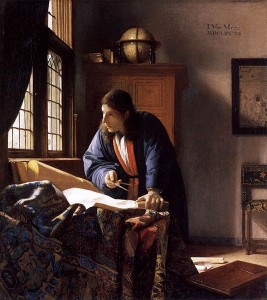 Anticipating plans for a future exhibition on Art and Science in the Early Modern Low Countries (ca 1550-1730), the Rijksmuseum and the Huygens Institute for the History of the Netherlands (Royal Dutch Academy of Arts and Sciences) organize a preliminary, two-day conference. This event will take place at the Rijksmuseum (September 17th) and the Trippenhuis (September 18th) in Amsterdam.
Anticipating plans for a future exhibition on Art and Science in the Early Modern Low Countries (ca 1550-1730), the Rijksmuseum and the Huygens Institute for the History of the Netherlands (Royal Dutch Academy of Arts and Sciences) organize a preliminary, two-day conference. This event will take place at the Rijksmuseum (September 17th) and the Trippenhuis (September 18th) in Amsterdam.
The Low Countries were flourishing in the early Modern Period, influenced by developments in Northern Italy and Southern Germany. First Antwerp and later Amsterdam emerged as centers of artistic and scientific innovation and creativity, and as nodal points in the exchange of goods, knowledge and skills. It is certainly no coincidence that a high level of artistic productivity in the Low Countries coincided with the so-called ‘Scientific Revolution’. Seen from a contemporary point of view, ars and scientia were complementary concepts, rather than opposites.
The aim of the conference is to explore the possibilities, prospects and also the pitfalls of the conjunction of ‘art and science’, and to contribute to the developing conversation between historians of art, historians of science and everyone interested in the visual and material culture of the sixteenth- and seventeenth-century Low Countries. The organizers look forward to receiving original submissions that address the relationships between art and science on both a material and a conceptual level.
Proposals which take objects, works of art, images, or illustrated texts as their point of departure are particularly welcomed. These may include ‘borderline’ topics – cross-overs between art and science, such as decorated shells, maps, models, pop-up books or anatomical preparations. Although the focus of the conference will be the Low Countries – both the South and the North – proposals which make reference to developments elsewhere shall certainly be considered, so long as the overall relevance for the main theme is clear.
Topics for discussion may include, but are not limited to:
- the fluid borders between art and nature, both in theory and in practice ( eg life casting techniques, strategies of display),
- the influence and use of new theories and instruments of visual representation ( eg the use of perspective, anatomical analysis, the telescope, microscope and camera obscura),
- the processes and techniques that artists used for the visual representation of the increasing body of traditional and new knowledge, such as different print media and the use of color, multi-sheet and interactive prints.
- the mediation of direct observation by visual conventions and the specific demands of illustrations concerned with the production of new knowledge (for instance with regard to previously unknown flora, fauna and peoples, and to anatomical and astronomical discoveries),
- the emergence in visual materials of new conceptions of objectivity and trustworthiness (eg the meaning of ‘ ad vivum ‘ and its cognates; the character and use of illustrations in natural histories and ‘scientific’ treatises),
- spaces where scholars, craftsmen and artists cooperated, discussed and produced new knowledge, such as cabinets of curiosities, the workshop, the anatomical theatre and the botanical garden,
- the role of religion in the definition and construction of knowledge and its influence on the visualization of knowledge.
We invite proposals for 20-minute and 10-minute papers, presenting the results of new or ongoing research. A 300-word abstract (preferably including an image or reference to a work of art), together with a short curriculum vitae, should be sent to both :
Jan de Hond (j.de.hond@rijksmuseum.nl)
Eric Jorink (eric.jorink@huygens.knaw.nl)
Proposals should be submitted no later than April 15, 2015 .
The selection of proposals will take place during the following month.

Leave a Reply
You must be logged in to post a comment.